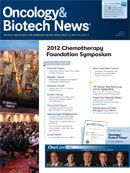Choosing a Tyrosine Kinase Inhibitor in Chronic Myelogenous Leukemia
The introduction of tyrosine kinase inhibitors for the treatment of chronic myelogenous leukemia has dramatically changed the course of the disease.
Hagop Kantarjian, MD
The introduction of tyrosine kinase inhibitors (TKIs) for the treatment of chronic myelogenous leukemia (CML) has dramatically changed the course of the disease, so that today there is an 85% chance of a 10-year survival rate for patients treated with imatinib. With five TKIs potentially available for CML, clinicians must weigh the relative advantages and toxicities of each when selecting a course of treatment. Hagop Kantarjian, MD, professor of Medicine, and chairman and professor, Leukemia Department, MD Anderson Cancer Center in Houston, Texas, detailed key considerations for selecting TKI therapy at the 2012 Chemotherapy Foundation Symposium.
Three TKIs are approved for frontline therapy in CML—imatinib, nilotinib, and dasatinib—and a total of five TKIs are available for use in different sequences and circumstances in patients with CML (Table). In addition, omacetaxine, although not a TKI, may have potential for use in combination therapy, Kantarjian said.
Efficacy, toxicities, disease status, salvage status, comorbidities, and cost all should factor into the choice of TKI in CML, Kantarjian said. The least controversial of those factors, he said, is cost: If a patient is paying out-of-pocket, imatinib is likely to be the least expensive therapy.
In terms of considering disease status in therapy selection, although TKIs have also improved survival in accelerated and blast-phase CML, that improvement is by no means ideal, Kantarjian said. For patients in transformation, TKIs should be used in combination and not as single-agent therapy, he said.
Table. FDA Approval Status of TKIs for CML
TKI
Frontline
Salvage
Imatinib
Approved
Approved
Nilotinib
Approved
Approved
Dasatinib
Approved
Approved
Bosutinib
Approved
Ponatinib
Approved
CML indicates chronic myelogenous leukemia; TKI, tyrosine kinase inhibitor.
Kantarjian compared the use of imatinib versus newer TKIs as frontline therapy in CML. In this setting, the newer TKIs have been shown to result in improved complete cytogenic response, major molecular response, complete molecular response, eventfree survival, and transformation rates. On average, the newer TKIs cause less chronic toxicity compared with imatinib.
“For all of these reasons, there is no doubt that second [generation] TKIs are going to get increased utilization as frontline therapy for chronic myeloid leukemia,” Kantarjian said. “What we have to keep in mind is so far, there is no survival benefit. Many patients who fail imatinib can be salvaged effectively with second [generation] TKIs.” But Kantarjian said that the choice of whether to use imatinib as frontline therapy versus one of the newer TKIs may come down to cost considerations.
One question that remains to be answered in this area is what price should be paid for what difference in survival or transformation at 5 or 10 years, Kantarjian said. The question will be particularly relevant when imatinib goes off-patent in the next few years and the price will presumably decrease. In three randomized trials of TKIs as frontline therapy (ENESTnd, DASISION, and BELA), on average, the second-generation TKIs reduced the cumulative incidence of transformation to accelerated phase/ blast phase in the first 2 to 3 years from about 5% to approximately 1.5%. The incidence of transformation on study (intent-to-treat population) was reduced by half, from 6% to approximately 3%.
OncLive TV Exclusive
Dr. Hagop Kantarjian on the Optimal Frontline Treatment for CML
“If second [generation] TKIs are effective in reducing the incidence of transformation in the first 2 to 3 years, but not later on, what you would expect is at 10 years, a difference in survival of 3% to 5%,” Kantarjian said. “If second [generation] TKIs reduce the incidence of transformation consistently across the years, then you will see a marked difference in the 10-year survival, which will justify their use in frontline therapy regardless of the cost.”




